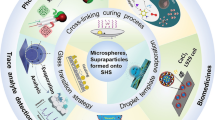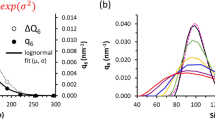Abstract
We review recent work on DNA-linked gold nanoparticle assemblies. The synthesis, properties, and phase behavior of such DNA–gold nanoparticle assemblies are described. These nanoparticle assemblies have strong optical extinction in the ultraviolet and visible light regions; hence, the technique is used to study the kinetics and phase transitions of DNA–gold nanoparticle assemblies. The melting transition of DNA–gold nanoparticle assemblies shows unusual trends compared to those of free DNA. The phase transitions are influenced by many parameters, such as nanoparticle size, DNA sequence, DNA grafting density, DNA linker length, interparticle distance, base pairing defects, and disorders. The physics of the DNA–gold nanoparticle assemblies can be understood in terms of the phase behavior of complex fluids, with the colloidal gold interaction potential dominated by DNA hybridization energies.






Similar content being viewed by others
References
Frank-Kamenetskii MD (1997) Biophysics of the DNA molecule. Phys Rep 288:13–60
Watson JD, Crick FHC (1953) Molecular structure of nucleic acids. Nature 171:737–738
Mirkin CA et al (1996) A DNA-based method for rationally assembling nanoparticles into macroscopic materials. Nature 382:607–609
Alivisatos AP et al (1996) Organization of nanocrystal molecules using DNA. Nature 382:609–611
Mucic RC et al (1998) DNA-directed synthesis of binary nanoparticle network materials. J Am Chem Soc 120: 12674–12675
Maeda Y et al (2001) Two-dimensional assembly of gold nanoparticles with a DNA network template. Appl Phys Lett 79:1181–1183
Coffer JL et al (1996) Dictation of the shape of mesoscale semiconductor nanoparticle assemblies by plasmid DNA. Appl Phys Lett 69:3851–3853
Torimoto T et al (1999) Fabrication of CdS nanoparticle chains along DNA double strands. J Phys Chem B 103: 8799–8803
Mitchell G et al (1999) Programmed assembly of DNA functionalized quantum dots. J Am Chem Soc 121:8122–8123
Pathak S et al (2001) Hydroxylated quantum dots as luminescent probes for in situ hybridization. J Am Chem Soc 123:4103–4104.
Cassell AM et al (1998) Assembly of DNA/fullerene hybrid materials. Angew Chem Int Ed 37:1528–1531
Braun E et al (1998) DNA-templated assembly and electrode attachment of a conducting silver wire. Nature 391:775–778
Martin BR et al (1999) Orthogonal self-assembly on colloidal gold-platinum nanorods. Adv Mater 11:1021–1025
Yan H et al (2003) DNA-templated self-assembly of protein arrays and highly conductive nanowires. Science 301: 1882–1884
Tsang SC et al (1997) Immobilisation platinated and iodinated oligonucloetides on carbon nanotubes. Angew Chem Int Ed 36:2197–2200
Guo Z et al (1998) Immobilization and visualization of DNA and proteins on carbon nanotubes. Adv Mater 10:701–703
Chen RJ et al (2001) Noncovalent sidewall functionalization of single-walled carbon nanotubes for protein immobilization. J Am Chem Soc 123:3838–3839
Shim M et al (2002) Functionalization of carbon nanotubes for biocompatibility and biomolecular recognition. Nano Lett 2:285–288
Baker SE et al (2002) Covalently bonded adducts of deoxyribonucleic acid (DNA) oligonucleotides with single-wall carbon nanotubes: synthesis and hybridization. Nano Lett 2:1413–1417
Dwyer C et al (2002) DNA-functionalized single-walled carbon nanotubes. Nanotechnology 13:601–604
Elghanian R et al (1997) Selective colorimetric detection of polynucleotides based on the distance-dependent optical properites of gold nanoparticles. Science 277:1078–1081
Storhoff JJ et al (1998) One-pot colorimetric differentiation of polynucleotides with single base imperfections using gold nanoparticle probes. J Am Chem Soc 120:1959–1964
Chan WCW, Nie S (1998) Quantum dot bioconjugates for ultrasensitive nonisotopic detection. Science 281:2016–2018
He L et al (2000) Colloidal Au-enhanced surface plasmon resonance for ultrasensitive detection of DNA hybridization. J Am Chem Soc 122:9071–9077
Park S-J et al (2002) Array-based electrical detection of DNA with nanoparticle probes. Science 295:1503–1506
Wang J et al (2002) Magnetically-induced solid-state electrochemical detection of DNA hybridization. J Am Chem Soc 124:4208–4209
Cao YC et al (2002) Nanoparticles with raman spectroscopic fingerprints for DNA and RNA detection. Science 297: 1536–1540
Maxwell DJ et al (2002) Self-assembled nanoparticle probes for recognition and detection of biomolecules. J Am Chem Soc 124:9606–9612
Weizmann Y et al (2003) Amplified DNA sensing 404 and immunosensing by the rotation of functional magnetic particles. J Am Chem Soc 125:3452–3454
Gerion D et al (2002) Sorting fluorescent nanocrystals with DNA. J Am Chem Soc 124:7070–7074
Sun Y, Kiang C-H (2005) In: Nalwa HS (ed) Handbook of nanostructured biomaterials and their applications in nanobiotechnology, vol 2. American Scientific Publishers, Stevenson Ranch, pp 224–246
Kiang C-H (2003) Phase transition of DNA-linked gold nanoparticles. Physica A 321:164–169
Anderson VJ, Lekkerkerker HNW (2002) Insights into phase transition kinetics from colloid science. Nature 416:811–815
Kushon SA et al (2003) Detection of single nucleotide mismatches via fluorescent polymer superquenching. Langmuir 19:6456–6464
Lockhart DJ, Winzeler EA (2000) Genomics, gene expression and DNA arrays. Nature 405:827–836
Hill AA et al (2000) Genomic anlaysis of gene expression in C. elegans. Science 290:809–812
Zhou B et al (2002) Human antibodies against spores of the genus Bacillus: a model study for detection of and protection against anthrax and the bioterrorist threat. Proc Natl Acad Sci USA 99:5241–5246
Liu J, Lu Y (2004) Adenosine-dependent assembly of aptazyme-functionalized gold nanoparticles and its application as a coloimetric biosensor. Anal Chem 76:1627–1632
Lipshutz RJ et al (1999) High density synthetic oligonucleotide arrays. Nat Genet 21:20–24
Austin RH et al (1997) Stretch genes. Phys Today 50:32–38
Taton TA et al (2000) Scanometric DNA array detection with nanoparticle probes. Science 289:1757–1760
Sun Y et al (2005) The reversible phase transition of DNA-linked colloidal gold assemblies. Physica A 354:1–9
Lukatsky DB, Frenkel D (2004) Phase behavior and selectivity of DNA-linked nanoparticle assemblies. Phys Rev Lett 92:068302–1–4
Drukker K et al (2001) Model simulations of DNA denaturation dynamics. J Chem Phys 114:579–590
Sun Y et al (2005) Melting transition of directly-linked gold nanoparticle DNA assembly. Physica A 350:89–94
Lazarides AA, Schatz GC (2000) DNA-linked metal nanosphere materials: structural basis for the optical properties. J Phys Chem B 104:460–467
Link S, El-Sayed MA (1999) Spectral properties and relaxation dynamics of surface plasmon electronic oscillations in gold and silver nanodots and nanorods. J Phys Chem B 103:8410–8426
Cohen I et al (2004) Shear-induced configurations of confined colloidal suspensions. Phys Rev Lett 93:046001–1–4
Schall P et al (2004) Visualization of dislocation dynamics in colloidal crystals. Science 305:1944–1948
Manley S et al (2004) Limits to gelation in colloidal aggregation. Phys Rev Lett 93:108302–1–4
Jin R et al (2003) What controls the melting properties of DNA-linked gold nanoparticle assemblies? J Am Chem Soc 125:1643–1654
Park SY, Stroud D (2003) Theory of melting and the optical properties of gold/DNA nanocomposites. Phys Rev B 67:212202–1–4
Harris NC, Kiang C-H (2005) Disorder in DNA-linked gold nanoparticle assemblies. Phys Rev Lett 95:046101–1–4
Harris NC, Kiang C-H (2006) Defects can increase the melting temperature of DNA-nanoparticle assemblies. J Phys Chem B 110:16393–16396
Acknowledgements
We also thank NSF DMR-0505814, NIH 1T90DK70121-01, Hamill Innovation Fund, and Welch Foundation C-1632 for support.
Author information
Authors and Affiliations
Corresponding author
Rights and permissions
About this article
Cite this article
Sun, Y., Harris, N.C. & Kiang, CH. Phase Transition and Optical Properties of DNA–Gold Nanoparticle Assemblies. Plasmonics 2, 193–199 (2007). https://doi.org/10.1007/s11468-007-9034-y
Received:
Accepted:
Published:
Issue Date:
DOI: https://doi.org/10.1007/s11468-007-9034-y




